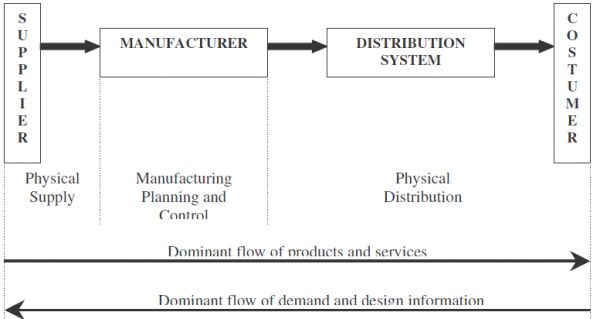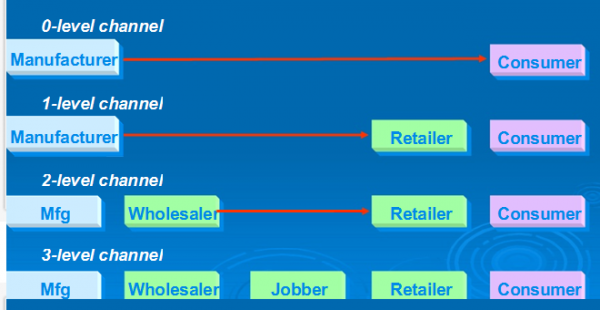14. Physical Distribution

In a Manufacturing Organization, material flow can broadly be classified into three phases as shown in above figure
• Flow of raw material from a supplier to the manufacturing company through Physical Supply
• Flow of material as they are processed, within a manufacturing company through the Manufacturing Planning and Control System
• Flow of finished goods from the manufacturing company to the end customers through Physical Distribution
The particular path in which the goods move (through distribution centers, wholesalers and retailers) is called the channel of distribution.
A "distribution channel" can be defined as
"all the organisations through which a product must pass between its point of production and consumption"
The specific way in which materials move depends upon many factors. For example:
- The channels of distribution that the firm is using;
- The types of markets served. Market characteristics such as the geographic dispersion of the market, the numbers of customers and the size of orders;
- The characteristics of the product;
- The type of transportation available to move the material.
All are closely related.
Distribution Channel Levels
The Producer and Consumer are part of every channel. The movement of goods through channels of distribution can be classified into channel levels as shown in the figure Zero Level Channel (also called direct distribution) consists of a producer sending the goods directly to the consumer.
One Level Channel contains one intermediary between the producer and the consumer
Two Level Channel contains two intermediaries...and so on.
In the figure above, Channel 1 is called a "direct-marketing" channel, since it has no intermediary levels. In this case the manufacturer sells directly to customers. An example of a direct marketing channel would be a factory outlet store. Many holiday companies also market direct to consumers, bypassing a traditional retail intermediary - the travel agent.
The remaining channels are "indirect-marketing channels".
Functions of a Distribution Channel
The main function of a distribution channel is to provide a link between production and consumption. Organisations that form any particular distribution channel perform many key functions:
Information Gathering and distributing market research and intelligence - important for marketing planning
Promotion Developing and spreading communications about offers
Contact Finding and communicating with prospective buyers
Matching Adjusting the offer to fit a buyer's needs, including grading, assembling and packaging
Negotiation Reaching agreement on price and other terms of the offer
Physical distribution Transporting and storing goods
Financing Acquiring and using funds to cover the costs of the distribution channel
Risk taking Assuming some commercial risks by operating the channel (e.g. holding stock)
All of the above functions need to be undertaken in any market. The question is - who performs them and how many levels there need to be in the distribution channel in order to make it cost effective.
Types of Markets Served
The types of market exposure strategies and the desired customer service levels make up the types of markets served.
An Intensively Distributed Market aims at maximizing the product availability in the market by establishing the maximum number of channel distribution points. This strategy becomes suitable for low cost consumer items and helps in mass-distribution. Examples
include pens, softdrinks etc.,
An Exclusively Distributed Market aims at having a limited number of distribution points for better administration, control and certain business interests. Examples include Garment stores (exclusive Raymonds outlets), Automobiles etc.,
A Selectively Distributed Market aims at having a select few distribution channels capable of providing a specified customer service thus catering to a niche market. In each of these strategies, desired customer service levels can be achieved by a detailed understanding of the customers, their buying habits, expectations and catering to the size of orders, timely delivery, speed and accuracy or order processing.
Product Characteristics and Transportation modes Product Characteristics (weight, fragility, perishability etc.,) and Transportation Modes (air, water, rail, road) also influence the movement and storage of goods and hence are taken into consideration during the design of distribution channels